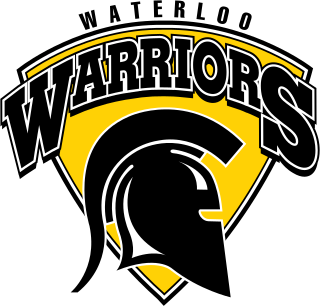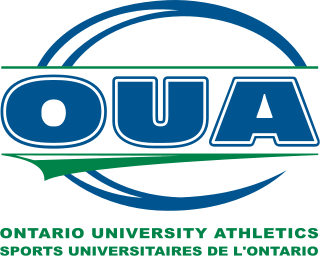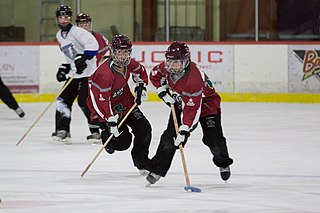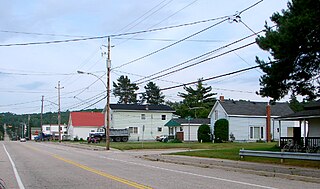Related Research Articles

The Western Mustangs are the athletic teams that represent Western University in London, Ontario, Canada. The school's athletic program supports 46 varsity teams. Their mascot is a Mustang named J.W. and the school colours are purple and white. The university's varsity teams compete in the Ontario University Athletics conference and the national U Sports organization. Western University offers 21 varsity sports for men and 19 for women which compete in the OUA conference. The university also offers cheerleading, women's ringette, women's softball, table tennis and ultimate frisbee, which compete outside the OUA conference, in sport-specific conferences and divisions.
Samuel Perry Jacks more commonly known as, "Sam Jacks," was a Canadian soldier in World War II, inventor, military and civic recreation director, sports coach, creator of the Canadian sport of ringette for girls and the creator and codifier of the first set of rules for floor hockey in 1936. He was born in Glasgow, Scotland, in 1915 and became a Canadian citizen after his parents had immigrated to Canada in 1920. Jacks died from cancer in 1975, at the age of 60.

The Waterloo Warriors are the intercollegiate sports teams that represent the University of Waterloo in Waterloo, Ontario, Canada. The Warriors have found success over certain spans in football, hockey, rugby, golf and basketball among others, and the Warriors have won national championships in ice hockey (1974), basketball (1975), and women's swimming (1975). For many years from the 1960s through the 1990s, Warrior basketball games attracted the largest and rowdiest basketball crowds in the country. The Warriors Football teams have won two Yates Cup Championships, in 1997 and in 1999.

Ontario University Athletics is a regional membership association for Canadian universities which assists in co-ordinating competition between their university level athletic programs and providing contact information, schedules, results, and releases about those programs and events to the public and the media. This is similar to what would be called a college athletic conference in the United States. OUA, which covers Ontario, is one of four such bodies that are members of the country's governing body for university athletics, U Sports. The other three regional associations coordinating university-level sports in Canada are Atlantic University Sport (AUS), the Canada West Universities Athletic Association (CW), and Réseau du sport étudiant du Québec (RSEQ).

Jayna Hefford is a Canadian retired ice hockey player and current chairperson of the Professional Women's Hockey Players Association.

Lori Dupuis is a Canadian women's ice hockey player.

The 1990 IIHF Women's World Championships was an international women's ice hockey competition held at Civic Centre in Ottawa, Ontario, Canada from March 19 to 25, in 1990. This was the first IIHF-sanctioned international tournament in women's ice hockey and is the only major international tournament in women's ice hockey to allow bodychecking. Full contact bodychecking was allowed with certain restrictions near the boards. The intermissions between periods were twenty minutes instead of fifteen. This has since been changed to the usual fifteen minutes.

Ringette is a non-contact winter team sport played on an ice rink using ice hockey skates, straight sticks with drag-tips, and a blue, rubber, pneumatic ring designed for use on ice surfaces. While sport was originally created exclusively for female competitors, it has expanded to now include participants of all gender identities. Although ringette looks ice hockey-like and is played on ice hockey rinks, the sport has its own lines and markings, and its offensive and defensive play bear a closer resemblance to lacrosse or basketball.

Trout Creek is a community and unincorporated area in the municipality of Powassan, Parry Sound District in Northern Ontario, Canada. It is in geographic South Himsworth Township; is located on Ontario Highway 11, 12 kilometres (7 mi) south of the town centre of Powassan; and is part of the Almaguin Highlands.

The first instances of organized women's ice hockey in Canada date back to the 1890s when it was played at the university level. The Women's Hockey Association claims that the city of Ottawa, Ontario hosted the first game in 1891. In 1920, Lady Meredith, an avid sportswoman and wife of Sir Vincent Meredith of Montreal donated the Lady Meredith Cup to the Quebec Ladies' Hockey Association, said to be the first women's ice hockey trophy created for a competition in Canada. At the time women competed in ankle-length skirts.
The Ontario Women's Hockey Association (OWHA) is the governing body of women's ice hockey in the Province of Ontario, Canada. The OWHA is a member of the Ontario Hockey Federation (OHF), the Ontario branch of Hockey Canada. The Association was formed in 1975 by Cookie Cartwright to generate interest in women's ice hockey. Roughly ten years later, Fran Rider became the association's executive director.

The Toronto Varsity Blues women's ice hockey program represents the University of Toronto in the Ontario University Athletics conference of U Sports. Three-time Olympic medalist Vicky Sunohara has served as head coach since the 2011–12 season.

The Provincial Women's Hockey League is a Junior women's ice hockey league in Ontario, Canada that was founded in 2004. It is considered to be the highest level of junior women's amateur ice hockey in Ontario, and is sanctioned by Hockey Canada and the Ontario Women's Hockey Association.

The U Sports Women's Ice Hockey Championship, is a Canadian university ice hockey tournament conducted by U Sports, and determines the women's national champion. The tournament involves the champions from each of Canada's four regional sports conferences. The Golden Path Trophy is awarded to the winners.
Queen's Gaels women's ice hockey is the representative women's ice hockey program of Queen's University at Kingston in Kingston, Ontario, Canada. The team plays in the women's ice hockey section of Ontario University Athletics (OUA), one of the four regional governing bodies that comprise U Sports.

Mirl Arthur "Red" McCarthy was a Canadian sportsperson, sport and recreation administrator, ice hockey player, founder and co-inventor of the sport of ringette, and for a time, a professional skating star and barrel jumper. He was inducted into the Ringette Canada Hall of Fame as a Founder in 1998.
The history of Canadian sports falls into five stages of development: early recreational activities before 1840; the start of organized competition, 1840–1880; the emergence of national organizations, 1882–1914; the rapid growth of both amateur and professional sports, 1914 to 1960; and developments of the last half-century. Some sports, especially ice hockey, lacrosse, curling, and ringette enjoy an international reputation as particularly Canadian. Although typically thought of as American, the origin of the sport of baseball began the Canadian town of Beachville, Ontario, and American football was initially developed by Canadians at McGill University before two different playing styles emerged, American football and Canadian football. Canadian sports attract large numbers of participants and huge audiences; hockey, played by 1.4 million Canadians, has become part of the national identity.
The following is a chronicle of events during the year 1982 in ice hockey.

Ringette in Canada began in 1963 when it was first conceptualized by Sam Jacks of North Bay, Ontario, in West Ferris. The sport of ringette is played in all 10 Canadian provinces and the Northwest Territories and involves an average of over 31,000 registered players every year. Canada is the location of ringette's origin where it is also recognized as a national heritage sport. The sport is governed nationally by Ringette Canada. Canadian provinces and territories have their own individual governing bodies in their respective jurisdictions.
Ringette Canada is the national governing body for the sport of ringette in Canada. It was established in 1974 with June Tiessen as its first President and has its current headquarters in Ottawa, Ontario. It is responsible for the organization and promotion of ringette on a nationwide basis and organizes Canada's semi-professional ringette league, the National Ringette League (NRL) which was established in 2004, with the league functioning as a committee under Ringette Canada.
References
- 1 2 3 4 5 Julia Galt (2020-02-28). "Newmarket author reveals untold stories of women's hockey history". newmarkettoday.ca. Retrieved 2021-09-15.
- 1 2 3 4 5 "Offside: Rhonda Leeman Taylor, Artsci'76". queensu.ca. 2 November 2020. Retrieved 2021-09-15.
- 1 2 3 Ian MacAlpine (2019-10-01). "Women's hockey pioneer writes book on sport's early challenges". thewhig.com/. Retrieved 2021-09-15.
- ↑ Taylor, Rhonda Leeman; Whitmarsh, Denbeigh (5 October 2019). OFFSIDE: - A Memoir - Challenges Faced by Women in Hockey. Rhonda Leeman Taylor. ISBN 9781999232313 . Retrieved 2021-09-15– via google.ca.
- ↑ Doug Jeffries (2019-10-16). "Rhonda Leeman Taylor's new book recounts hockey career, fight for gender equality in sports". globalnews.ca/. Retrieved 2021-09-15.
- ↑ "Ringette (A Game on Skates for Girls) Rules 1965-66". Ringette Calgary. Society of Directors of Municipal Recreation of Ontario/Ringette Canada.
- ↑ "Sport Canada and the Public Policy Framework for Participation and Excellence in Sport"
- ↑ Doug Jeffries (2018-11-02). "The Kingston Red Barons just wanted to play hockey". newmarkettoday.ca. Retrieved 2021-09-15.
- ↑ Ian McAlpine (2018-10-12). "Red Barons to speak at Kingston Historical Society meeting". leaderpost.com/. Retrieved 2021-09-15.
- 1 2 MacAlpine, Ian (1 October 2019). "Women's hockey pioneer writes book on sport's early challenges". The Kingston Whig-Standard . Retrieved 15 September 2022.